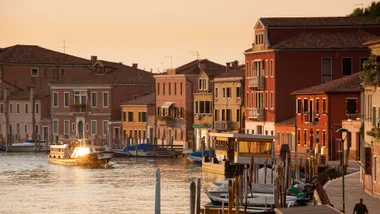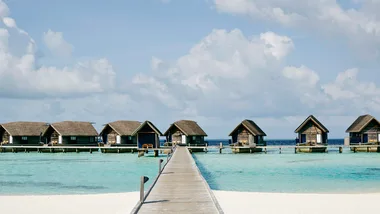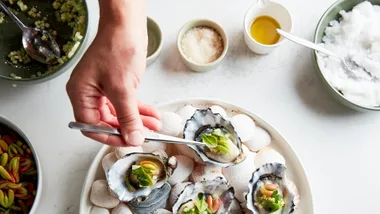**So you’ve been to El Bulli?
** Yes, finally, and boy am I glad I did.
**Is it really the best restaurant in the world?
** I haven’t been to all of them yet, but I’ve been to a fair whack of other places touted as top contenders for the crown and, as far as I can see, El Bulli has a pretty good claim to being ahead of the pack. It’s both a dizzying diversion and a very satisfying meal.
**How on earth did you get a reservation? I thought their entire season was booked out overnight in November of last year?
** It’s true, and apparently they get hundreds of thousands of reservation requests for what is, when it boils down to it, a 50-seat restaurant that only opens from June to December (the chefs spend the other six months of the year working on the menu). Bizarre as it may sound for a place where tables are so coveted, though, they do get the occasional cancellation. Email them to let them know when you’ll be in Spain, and then keep calling and emailing with your fingers crossed the whole time in the hope that someone can’t make it.
Do they get walk-ins?
Apparently it happens occasionally, but I wouldn’t recommend it, not least of all because the restaurant is pretty much in the middle of nowhere, and there’s a distinct absence of plan-Bs. You might want to pack some Space-Food Sticks, just to be on the safe side.
**Is it as much of a pain to get to as I’ve heard?
** It’s not a total breeze. There’s the whole flying-to-Spain aspect, of course, and then it’s about two hours’ drive north of Barcelona. We only got the nod a couple of days beforehand, so we took the bus to Girona, a pretty 13th-century hill town, then the train to Figueres (it’s Salvador Dalí’s birthplace), then a short bus to Roses, the nearest town to El Bulli. The Costa Brava is beautiful. Roses, however, ain’t. It’s a resort town with overtones of the lesser Gold Coast suburbs. The odyssey continues with the eight-kilometre cab ride to the restaurant itself – a drive up into the hills and along deserted cliffs to Cala Montjoi, a little cay home to a couple of houses – and some random dog-walkers. There, surrounded by eucalypts and wild fennel at the end of a crunchy gravel drive overlooking a calm Mediterranean, is the restaurant currently thought to be the world’s best.
What’s the place like?
Not at all what you might expect. Where other leading restaurants try to dazzle you as much with décor as dinner, El Bulli looks very much like the traditional Spanish restaurant it was when Ferran Adrià, its current chef and co-owner, joined the staff as a 22-year-old line-cook in 1984. The look is low-key, a series of timber-beamed whitewashed rooms perched on a cliff decorated with all sorts of art, including lots of pictures of bulldogs rendered in various media and a framed photo of The Rolling Stones from the inside cover of Beggars Banquet dedicated by photographer Michael Joseph.
**Bulldogs?
** Yeah, ‘El Bulli’ translates as The Bulldog, and, if the various paintings and framed representations around the restaurant are a guide, they mean the more pug-like breed – what we’d call a French bulldog – rather than the jowlier English number. I don’t know if it’s projection or association, but I swear Adrià has a touch of the ‘bulli’ himself.
**And the diners?
** Adrià has said that he doesn’t want the restaurant to become the sole preserve of millionaires and big-shots, and for it to still be accessible to what he terms normal people. Certainly there were tables present which had the aura that only very serious cash can provide – a party of Japanese tech-aristos, a Clark Kent-haired American financier-playboy and his Darryl Hannah-like consort – but there were also people who, like us, just like to eat, who stood in the carpark and asked us to take their picture while they grinned like the lottery winners of sorts they were. The vibe certainly wasn’t one of a hushed gastro-temple, but of a convivial group of strangers united from different corners of the globe by their interest in a little bit of culinary magic.
**How’s the service?
** Perfect in terms of pacing – there’s never a dull moment, but they know when to keep their distance – and they’re surprisingly funny and at ease with the overall silliness of the enterprise, without being undignified or less than diligent in their duties. They’re adept at explaining not only what the food is, but how to eat it without being in-your-face. The rhythm of ‘eat it in one bite’, ‘try a bite of this, then dip the other one in that and try it again’ and so on becomes so familiar so quickly that you’re almost at a loss when you’re presented with something as straightforward as a plate, fork and spoon (a great many of the early courses are eaten with your fingers, so you’d do well to wash your hands before dinner) but no instructions. Juli Soler is a laid-back and charming host, too, and there’s something very cool about the way every table gets to meet Adrià and poke their heads into the kitchen on the way in.
**Was there much in the way of this foam stuff people are always talking about?
** Well, yes, a bit. I mean Adrià was the one who thought the idea up, but he’s also very inventive in the way he uses it, and delivers foams of more palate-pleasing taste and texture than I’ve seen anywhere else. His fascination this season (they ‘retire’ each year’s menus and start afresh each season) seems to be spherification – using chemicals to make little blobs and bubbles of liquid contained in a thin soft membrane of themselves.
Was the food actually any good?
Post-mortems of El Bulli’s cuisine are unusual among discussions of three-starred restaurants in that they focus not so much on the degree of a dish’s success or the minutiae of the menu so much as whether you were able to eat certain dishes at all. But while the adjectives that pepper such conversations ranges from ‘challenging’ to ‘hateful’, it has to be said that you don’t travel all this way for comfort food you could have at home, and, in fairness to the restaurant, they give you a bit of an idea what you’ll be eating (though no printed menu until later), and ask if there’s anything you’d prefer not to eat. Again, it seems churlish to do anything less than the whole hog, like going to a Rothko show and asking for something a bit more figurative, so I asked them to give it to me with both barrels and not spare the horses.
**So it was bad?
** Not at all. A couple of things took me outside my comfort zone – I didn’t relish the razor clams ‘escabeche’, which were raw and somewhat bitter, while Myffy, my girlfriend, was less than entranced by the spheres of liquid lamb’s brains. They were certainly interesting, though, and by no means bad, and two courses out of a total of 33 is a pretty impressive strike rate. More to the point, while they were a captivating sensory experience, they also amounted to just the right amount of food, and there was no danger of having to make a pit-stop on the way back to the hotel for a peanut butter sandwich. I think the snails’ eggs (“When you say snails’ eggs,” I asked the waiter, “do you mean ‘snail’s eggs’ or the actual eggs of snails?”) may have thrown more than a few diners.
Did you say 33 courses?
Maybe it was 37. But don’t despair – many of these ‘courses’ are not more than a single bite, and it’s pretty light stuff. Much of what defines the sort of New Food that El Bulli is pioneering is the work to deliver as much flavour and texture as possible without getting weighed down by bulk.
**And the highlights?
** Popping what you think is a green olive into your mouth only to find it’s spherified liquid green olive is a pretty exciting way to kick things off, and then it’s a blur of beetroot-yoghurt meringues, an incredible black sesame sponge cake with the texture of crumbling lace (breaking down the line between entrée, main and dessert is something of a hallmark), and raspberries touched with vinegar and wasabi. Touches like the drops of sweet Pedro Ximénez sherry, spherified to resemble raisins, accompanying a single perfect sardine, or the fat heads of white asparagus, all cooked in different ways and dressed with little balls of frozen egg yolk which melt to enrich the sauce, show brilliance. For all the processing and polish, they avoid the trap that many so-called molecular gastronomers have fallen into by providing enough in the way of real textures and genuine savoury flavours to keep you feeling like you’re eating jazzed-up baby food. I could name you 10 other dishes I had over the same four hours that were just as good. I haven’t even mentioned the play on bean soup with the puree of white beans wrapped in a gossamer sheet of the finest jamón, or the pita of Iberian ham fat and veal bone marrow, let alone the raspberry butterfly perched on a hillock of yoghurt covered in liquorice powder.
**What do you think makes it special?
** For one thing, the quality of the ingredients and the consistency of the technique were pretty much flawless, bedrock for all the other stuff going on. I also like the fact that Adrià & Co. reject the idea that any one ingredient is more valuable to the diner than any other, so the menu is free of the over-reliance on standbys like foie gras, lobster and truffles seen at other three-stars, things that require money, rather than skill, to present. Instead, you get things that are genuinely rare and interesting. The pick of the night for me was a dish called ‘the sea’, which was basically nine kinds of seaweed, maybe half of them familiar, some cooked, some not, and all very interesting to eat. They’re arranged in order of increasing intensity of flavour and surround a little puff of sea foam. I can’t claim to have eaten anything like it anywhere in the world.
**How do you match wine to that stuff?
** To paraphrase the sommelier, you can’t, so you shouldn’t worry too much about it and just drink something you enjoy. “You’re best off picking some lightish whites you like,” he said, and there was plenty to like on the hefty list, “and we’ll bring you a glass here and there to match with certain courses.” To his credit, too, the González Byass Oloroso Alfonso with the liquid lamb’s brains, for one, was an inspiring pairing.
**And was it very, very expensive?
** Yes and no. The menu is a set 185 euros a head, and for us, taking it easy on the wine, it was 530 euros for two all up, so around $A1000. (The mark-ups on Spanish and particularly Catalan wines were surprisingly modest.) It’s a lot more than lunch at McDonald’s, certainly, but a lot less than dinner at most of the other European three-stars and plenty of other restaurants that aren’t anywhere near as much of a blast. People blow reams of money on stereo equipment, cars, horses, blackjack, dresses, theatre, sport and class-A drugs. If food is what excites you, then this is money well spent.
**Was it worth it?
** I was on a high for days afterwards and even now, months later, my mind boggles (and my mouth waters) at the thought of the meal. I’d do it again without a second thought at a moment’s notice.
**So the emperor really is wearing clothes?
** Yep, and they rock. It’s by no means something you’ll do every day, and perhaps not something that can be widely imitated with success, but if you dine for pleasure, El Bulli really is at the top of the heap. I’ll be back. Somehow.
El Bulli, Cala Montjoi, Roses, Girona, Spain , +34 97 215 0457, elbulli.com. Email Luis Garcia (aka Señor No) at [email protected] from October for reservations for the coming year.
 Courtesy El Bulli
Courtesy El Bulli









